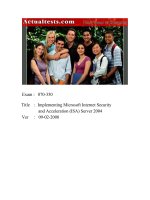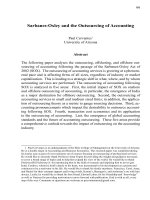The goal of teachers docx
Bạn đang xem bản rút gọn của tài liệu. Xem và tải ngay bản đầy đủ của tài liệu tại đây (15.29 KB, 9 trang )
The goal of teachers who use the Communicative
Approach is to have students become
communicatively competent.
“the goal of teachers who use the Communicative
Approach is to have students become communicatively
competent. While this has been the stated goal of many of
the other methods, in the Communicative Approach the
notion of what it takes to be communicatively competent is
much expanded.” State the reasons why you are for or
against the above idea.
(The notion of communicative competence as expanded in
the communicative approach)
In the English language teaching methods come and go
but few can establish themselves firmly in the field. The
Communicative Approach is one of those few exceptions it
has gained much popularity since its advent in the late
1960s. Most of the value of this approach lies in the fact
that it expands the notion of communicative competence
in such a way that no other method is able to.
First, the Communicative Approach highlights the fact that
understanding language functions is an important aspect
of communicative competence. This can be clearly seen in
the following comparison. The Direct Method, the Audio-
Lingual Method and the Communicative Approach are
similar in that they all aim at teaching language for
communication. However, each of them has its own way
to achieve its goal. While the Direct Method tries to
establish a direct link between the target language and
meaning by immersing students in a rich sample of the
structural and lexical items being taught and the Audio-
Lingual Method insists on mastery of structural patterns
through imitation and repetition, the Communicative
Approach stands out with its emphasis not only on
linguistic forms and meaning but also on functions. It
claims that as language is used for performing a variety of
functions such as apologizing, requesting, thanking,
inviting, an understanding of language functions is really
necessary. Learners need to know that a function can be
realized by different forms or that a form can serve
different functions. What is important, learners must draw
on this knowledge to choose the most appropriate form to
fulfill the function intended. So, though the Communicative
Approach is not the first to put forward the idea of teaching
a second/foreign language for communication, it is
definitely the first to advocate the learning of language
functions to gain communicative competence.
The Communicative Approach emphasizes that the ability
to use language appropriately is another essential aspect
of communicative competence. The principle applied here
is that grammatical competence and lexical knowledge are
not enough to enable students to operate efficiently in the
target language. They must be able to use the language
appropriate to the speech event they find themselves in.
Some variables that decide the appropriateness of their
language use are the purpose of their interaction, the role
relationships between them, the topic they are engaged in
and the shared knowledge they have. In other words, by
considering who they are talking to, what they are talking
about, when, where, and why they are talking, speakers
know what words to use. And of course, the ability to use
language appropriately helps to distinguish skilled
communicators from unskilled ones.
The Communicative Approach also points out that the
ability to develop strategies that can ensure effective
communication is an indispensable part of communicative
competence. As the Communicative Approach views
langue as a vehicle for communication the process of
negotiating meaning receives much attention. Engaged in
oral communication, speakers not only have to make
themselves understood but also have to interpret the
listener’s intention correctly. To do this they need to
employ a number of strategies to make sure that
communication can take place smoothly. These strategies
cover a wide range, from initiating and maintaining
communication, sharing and clarifying information to
reparing, redirecting and terminating communication.
Obviously, successful communicators must be able to
devise strategies that suit them as well as the social
context they are involved in.
It can be concluded that the concept of communicative
competence as defined by the Communicative Approach
is very broad indeed. It embraces three fundamental
dimensions: the ability to use linguistic means to realize a
variety of language functions, the ability to use language
appropriately with due consideration of the social context
in which communication takes place and the ability to
develop strategies to manage the negotiation of meaning.
This specification of communicate competence is the
hallmark of the communicative Approach because it
cannot be founding the theoretical framework of any other
method of or approach to language teaching.









